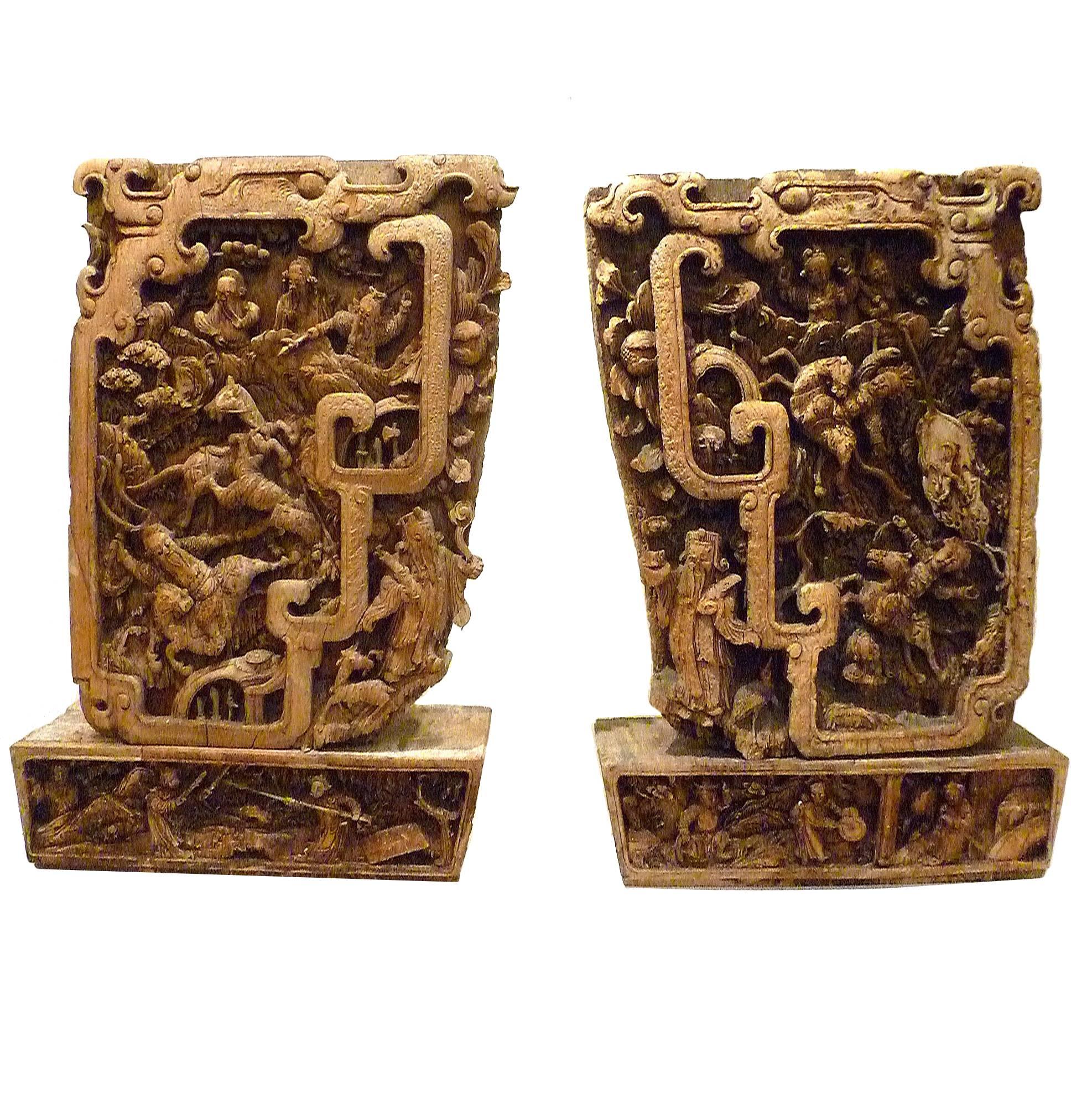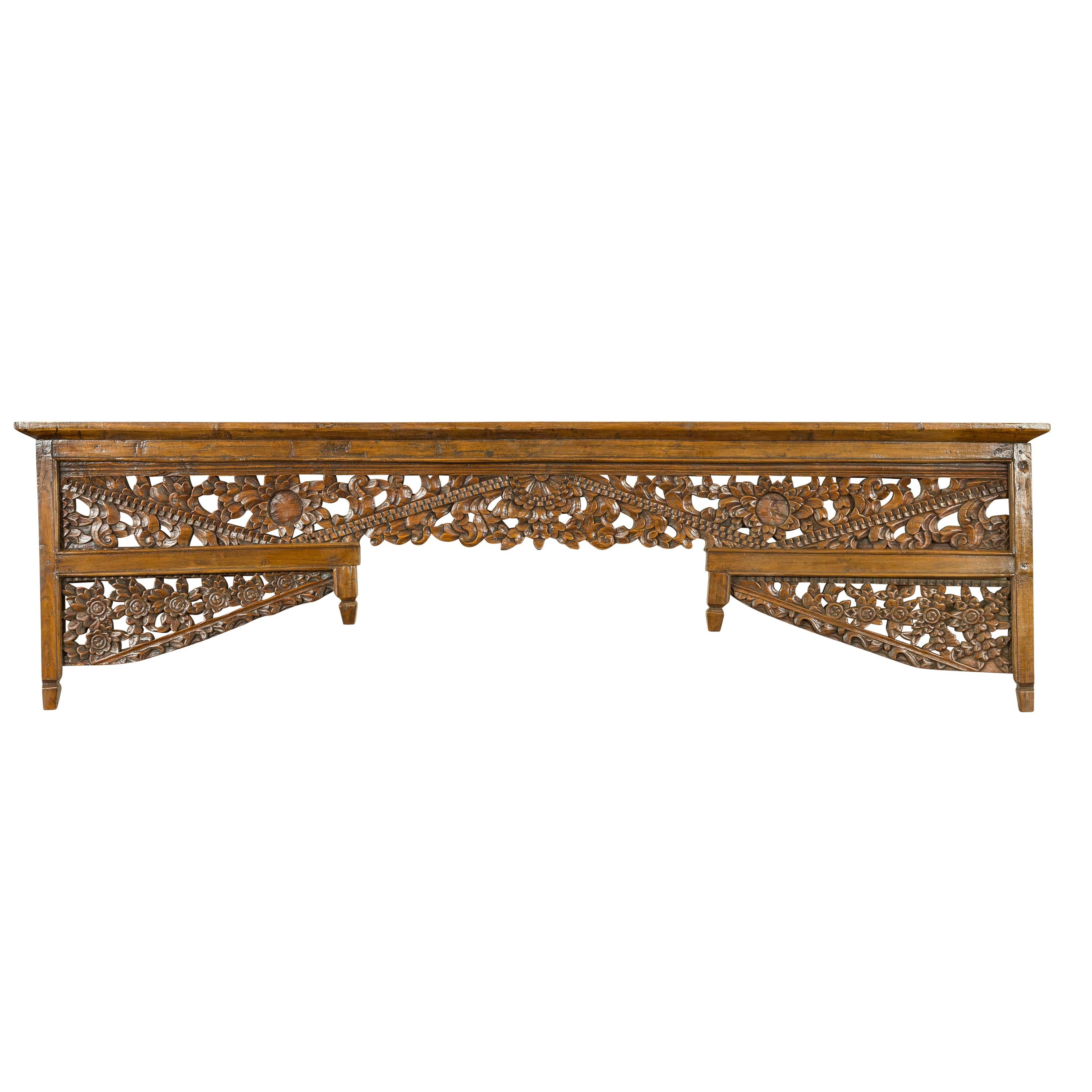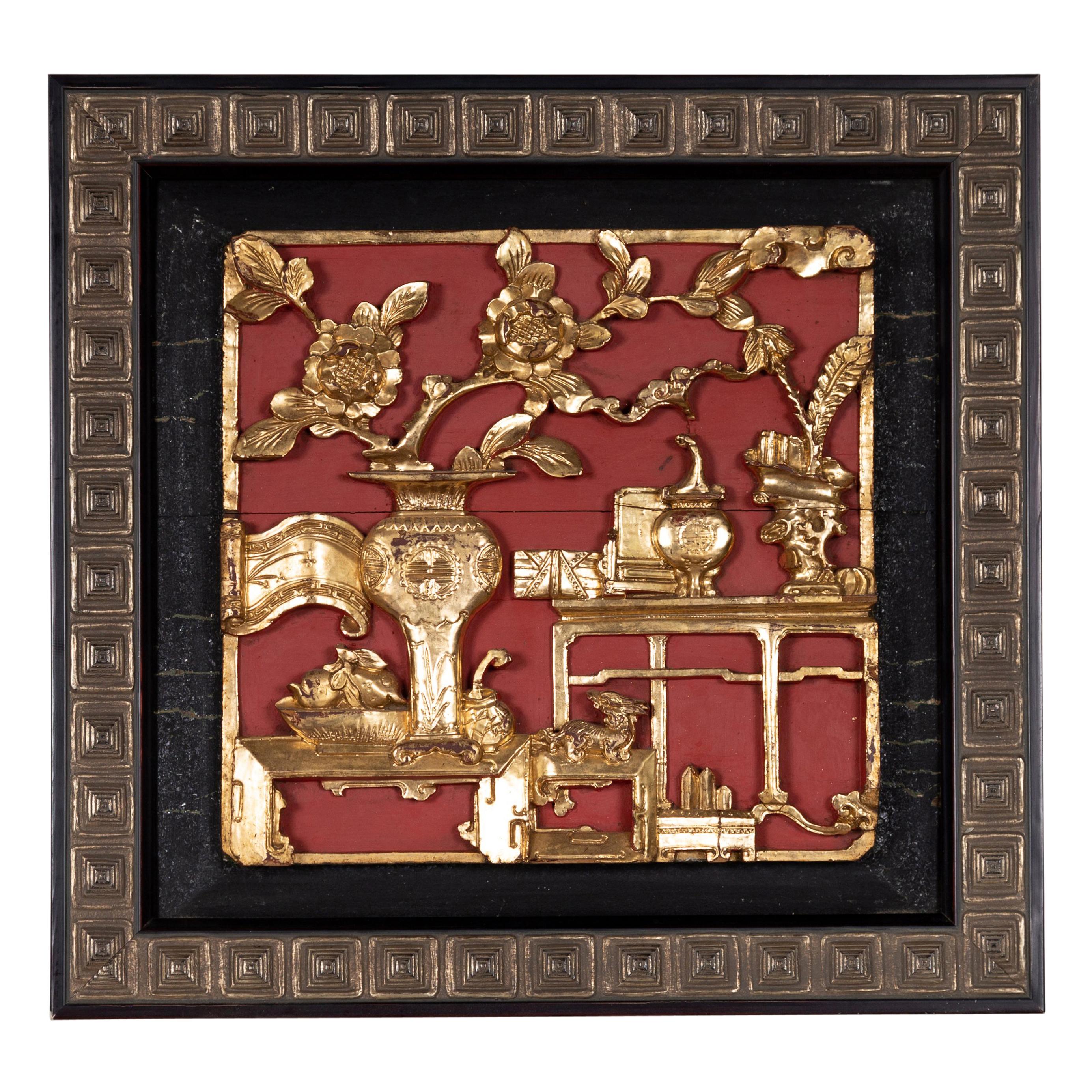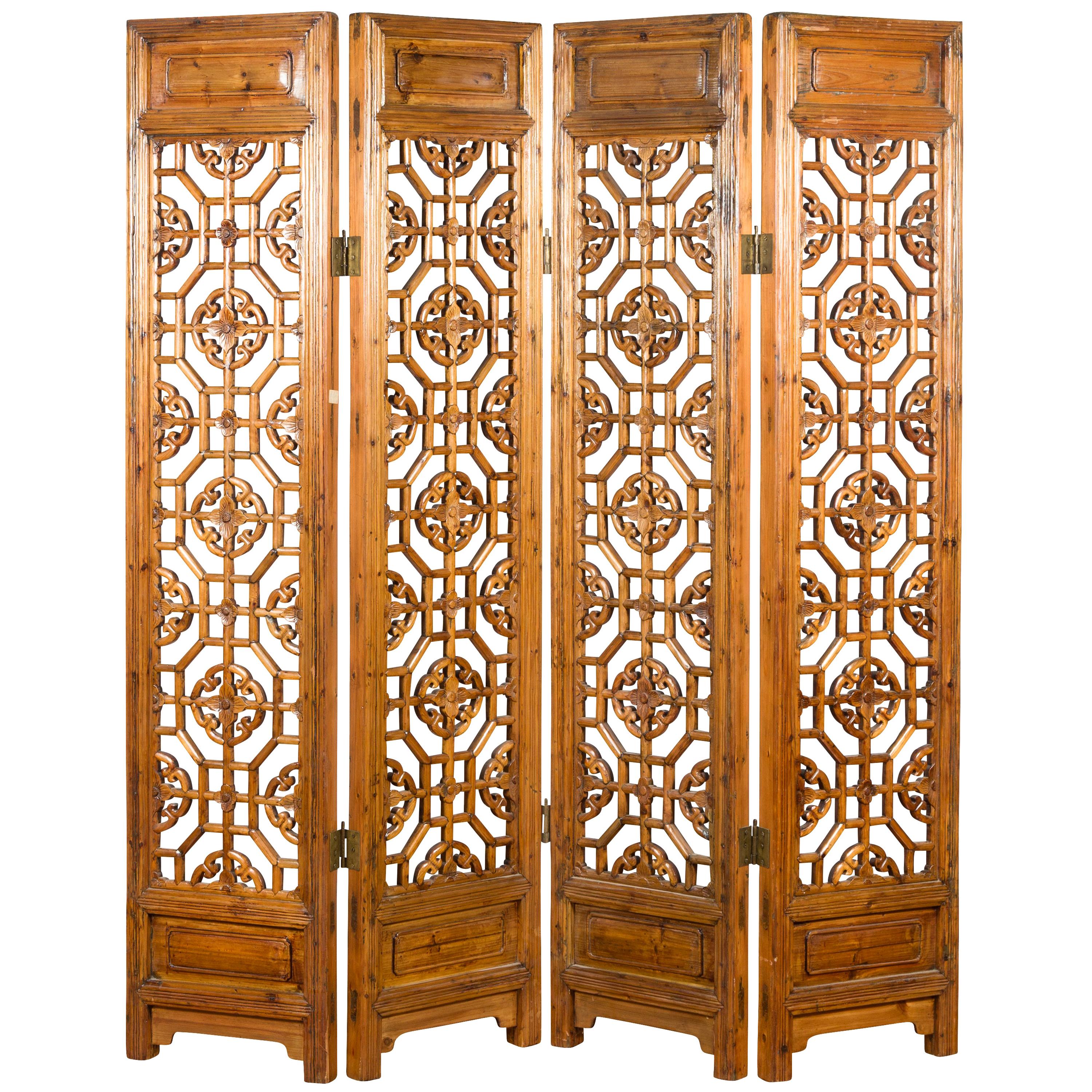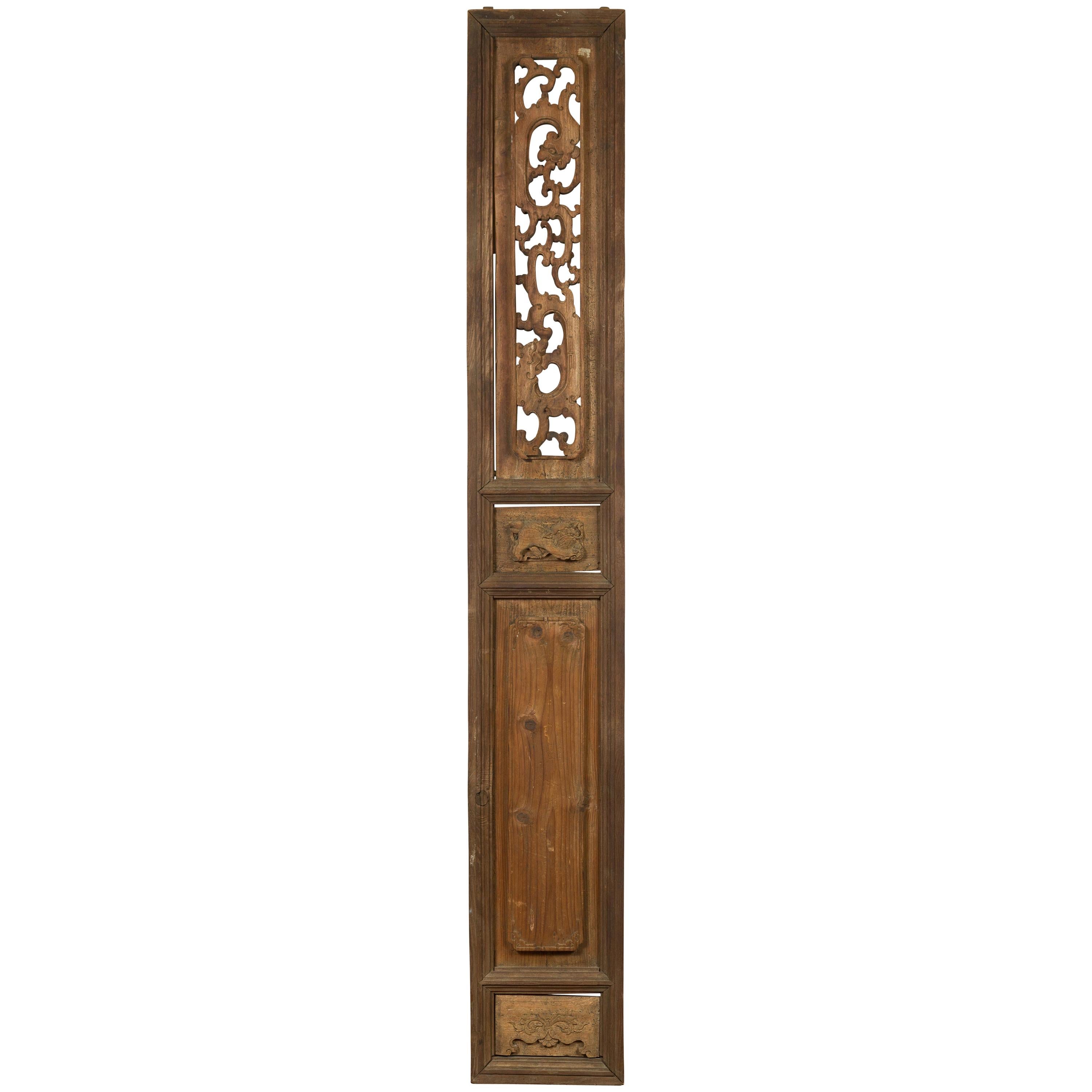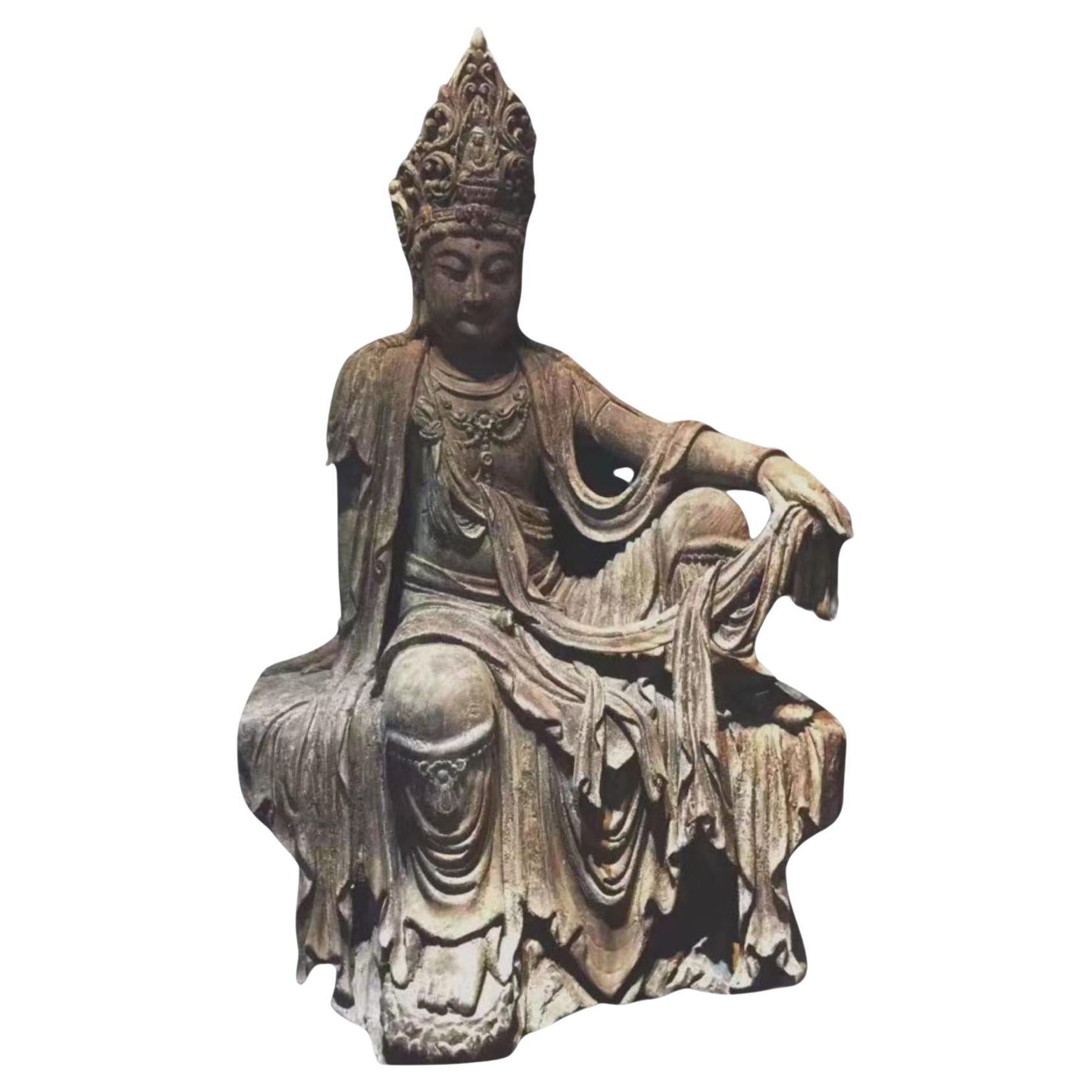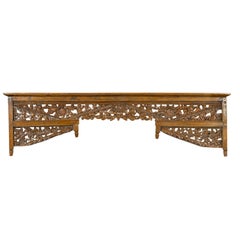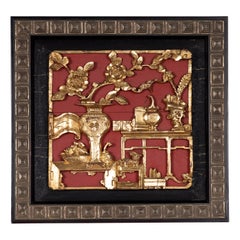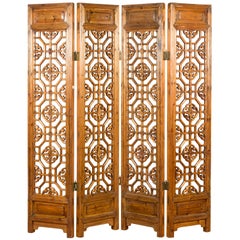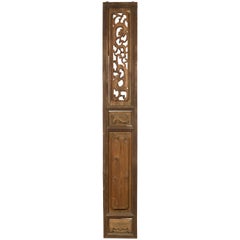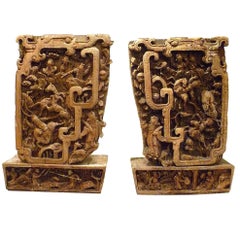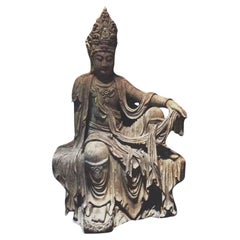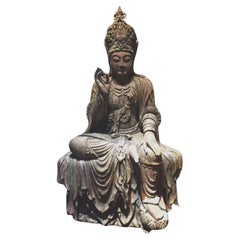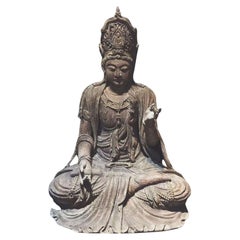Items Similar to Late Qing Dynasty Fretwork Panel with Phoenix, Bats and Geometric Maze
Want more images or videos?
Request additional images or videos from the seller
1 of 21
Late Qing Dynasty Fretwork Panel with Phoenix, Bats and Geometric Maze
About the Item
A Chinese late Qing Dynasty period elmwood panel circa 1900 with carved phoenix in central medallion, surrounded by flowers, bats and scrolling foliage. Experience the allure of Chinese artistry with this late Qing Dynasty period elmwood panel, circa 1900. Masterfully carved, this panel is a striking composition of symbolic motifs and intricate detailing, making it a captivating addition to any interior space.
The central feature of the panel is a magnificent phoenix, an auspicious legendary bird in China known for its symbolic representation of high virtue, grace, and prosperity. Nestled within a medallion, the phoenix is surrounded by an enchanting array of flowers and scrolling foliage, meticulously carved to convey an innate sense of movement and life.
Adding to the panel's visual interest are bat motifs on the exterior, a symbol of good fortune and happiness in Chinese culture, and a geometric maze of round fretwork, a testament to the artisan's skill and attention to detail. The lower section showcases two additional carved panels, further enhancing its artistic appeal.
The panel is equipped with two hinges at the top, allowing for easy and secure wall mounting. Its rich patina and timeless design make this elmwood panel a standout piece for those seeking to bring a touch of historic elegance to their décor.
Whether you're an aficionado of Qing Dynasty artwork or appreciate the depth and beauty of Chinese culture, this elmwood Ppanel serves as a striking testament to the richness of Chinese art and history.
- Dimensions:Height: 43.5 in (110.49 cm)Width: 35.5 in (90.17 cm)Depth: 1.5 in (3.81 cm)
- Style:Qing (Of the Period)
- Materials and Techniques:
- Place of Origin:
- Period:
- Date of Manufacture:circa 1900
- Condition:Wear consistent with age and use. Please refer to the various additional photos for further condition detail and contact us with any questions!
- Seller Location:Yonkers, NY
- Reference Number:Seller: YN2322 / FEA Home1stDibs: LU863934321652
About the Seller
5.0
Platinum Seller
Premium sellers with a 4.7+ rating and 24-hour response times
Established in 1968
1stDibs seller since 2009
1,136 sales on 1stDibs
Typical response time: <1 hour
- ShippingRetrieving quote...Shipping from: Yonkers, NY
- Return Policy
Authenticity Guarantee
In the unlikely event there’s an issue with an item’s authenticity, contact us within 1 year for a full refund. DetailsMoney-Back Guarantee
If your item is not as described, is damaged in transit, or does not arrive, contact us within 7 days for a full refund. Details24-Hour Cancellation
You have a 24-hour grace period in which to reconsider your purchase, with no questions asked.Vetted Professional Sellers
Our world-class sellers must adhere to strict standards for service and quality, maintaining the integrity of our listings.Price-Match Guarantee
If you find that a seller listed the same item for a lower price elsewhere, we’ll match it.Trusted Global Delivery
Our best-in-class carrier network provides specialized shipping options worldwide, including custom delivery.More From This Seller
View AllQing Dynasty Architectural Wooden Temple Panel with Detailed Floral Carvings
Located in Yonkers, NY
A Chinese architectural wood temple panel from the 19th century, with floral carvings. This exquisite Qing Dynasty architectural wood temple panel from the 19th century is a testamen...
Category
Antique 19th Century Chinese Qing Sculptures and Carvings
Materials
Wood
Qing Dynasty Giltwood and Red Painted Floral Architectural Panel in Frame
Located in Yonkers, NY
A late Qing Dynasty period giltwood architectural panel on red ground, with floral motifs, set in new frame. Delve into the rich tapestry of the late Qing Dynasty period with this gi...
Category
Early 20th Century Chinese Qing Decorative Art
Materials
Wood, Giltwood
Qing Dynasty Period Fretwork Four-Panel Screen with Geometric and Floral Motifs
Located in Yonkers, NY
A Qing Dynasty fretwork four-panel screen with geometric motifs and floral accents. This late Qing Dynasty period fretwork four-panel screen, crafted in the early 20th century, offers a harmonious blend of geometric precision and floral delicacy. Each of the four vertical wooden panels is adorned with meticulously arranged pierced geometric motifs, gracefully punctuated by delicate floral accents. The composition is framed by raised panels at the top and bottom, adding an element of depth and sophistication to the piece. The screen's warm honey-colored patina enhances the intricacy of the fretwork, creating a subtle yet captivating visual effect.
Perfect for adding a refined touch to any home, this four-panel screen can be used in various ways to complement your decor. Position it as an elegant room divider in a spacious living room, or use it as a decorative accent against a wall to draw the eye and add depth to the room. Its intricate patterns allow light to filter through, creating an ever-changing play of shadows that brings warmth and character to the space. With its rich historical roots and timeless design, this Qing Dynasty screen...
Category
Early 20th Century Chinese Qing Screens and Room Dividers
Materials
Wood
19th Century Qing Dynasty Carved Wood Panel with Cloud Motifs and Guardian Lion
Located in Yonkers, NY
A Chinese Qing dynasty carved wooden architectural panel from the 19th century, with pierced cloudy motifs and guardian lion. Hand-carved du...
Category
Antique 19th Century Chinese Qing Architectural Elements
Materials
Wood
Qing Dynasty Terracotta Head Sculpture with Headdress and Distressed Finish
Located in Yonkers, NY
An antique Qing Dynasty hand painted terracotta head from the 19th century, with striking features and headdress. This antique Qing Dynasty terracotta head from the 19th century draw...
Category
Antique 19th Century Chinese Qing Sculptures and Carvings
Materials
Terracotta
Antique Qing Dynasty Wooden Temple Corbel with Red Polychromy and Carved Pagodas
Located in Yonkers, NY
A Qing Dynasty hand carved wooden temple corbel from the 19th century, with characters, pagodas, vegetation and red polychromy. This antique Qing Dynast...
Category
Antique 19th Century Chinese Qing Sculptures and Carvings
Materials
Wood
You May Also Like
Pair of Qing Dynasty Architecture Carving Panels
Located in Greenwich, CT
Pair of Qing dynasty architecture carving panels, detail carvings with warriors riding horses.
Category
Antique 19th Century Chinese Qing Sculptures and Carvings
Materials
Wood
$3,600 / set
A Large Chinese Carved Wood Figure of Guanyin, Late Qing Dynasty
Located in ARMADALE, VIC
Description:
A fine depiction of Guanyin, possessing the regal tranquillity that the Chinese Bodhisattva of compassion has come to be visually associated with. Marked by an urna signifying her spiritual enlightenment and crowned with a diadem depicting the Buddha Amitabha, the figure is immediately recognisable as Guanyin. Her androgynous figure is gracefully poised in the Lalit asana or “royal ease”, the pose classical in representations of the deity. The figure is asymmetric, with the weight of her supple form falling upon her left hand placed against the base, her right knee raised and left pendant. Her right hand rests upon her raised knee, delicately pinching at her draped attire. At first unassuming, this gesture may be suggestive of the Apana Mudra, the seal of purification. This Mudra is associated with physical wellbeing, fecundity and the cleansing of the body. Though she is adorned in the princely garb of dhoti, she bears features of idealised feminine beauty as prescribed in Asian art. With plump cheeks and near pouted lips, her full face gazes down upon the viewer with an empathetic and half-lidded gaze, upholding her title as ‘One who hears the cries of the world.’
Notes on the item:
Guanyin is the Chinese interpretation of Avalokiteshvara, the Indian Bodhisattva of compassion. The term “Bodhisattva” is derived from the Sanskrit “Bodhi”, meaning ‘awakening’ or ‘enlightenment’, combined with “Sattva”, meaning ‘spirit’ or ‘being’, referring to one on the path to achieving enlightenment. Bodhisattvas in Mayahana Buddhism are recognised as figures who have effectively achieved enlightenment yet relinquish their accension to nirvana in order to remain amongst mankind in the ultimate act of compassion to aid as spiritual guides. As such, the Bodhisattva inhabit a liminal space between samsara and nirvana; enlightened beings that maintain a relationship with humanity that buddhas cannot, as attaining Buddhahood necessitates the abandonment of all worldly attachments, including mankind. Guanyin’s very name, ‘One who hears the cries of the world’ highlights this role as a compassionate figure who acknowledges the suffering and strife of man. Along with Mahāsthāmaprāpta, a fellow bodhisattva, Guanyin serves as an attendant to Buddha Amitabha, with these three deities recognised as the Three Sages of Western Pure Land Buddhism, a sect of Mayahana Buddhism popular in East Asia.
Avalokiteshvara is commonly posited to have been adopted from Indian Buddhism into China as Guanyin around 200-400 CE, however it was the Tang dynasty (618-907) which saw the popularisation of the deity. By the Ming (1358–1644) and Qing (1644–1911) dynasties, Guanyin held the position as the most popular female deity in China. The unique state of religion in China held no monolithic canon regarding Buddhism and saw the assimilation of several belief systems, primarily Daoism, Buddhism and Confucianism. Consequently, Guanyin became a deity to be revered beyond Buddhism alone, appointed as both an official imperial deity and Daoist deity in the 12th century. Guanyin may also be seen to fulfil the role of idealised femininity as prescribed by Confucianism, with the scarcity of female Chinese deities perhaps accounting for the gradual gender shift Guanyin underwent.
The Indian Avalokiteshvara is unequivocally recognised as male, whilst the supposed gender of Guanyin remains contentious. Although there is a clear shift from the masculine Avalokiteshvara towards a more feminine representation, it is unclear if Guanyin is understood to be entirely feminine, to inhabit qualities of both genders or to be elevated beyond gender entirely, embodying neither. Depictions of Guanyin are highly androgynous, which some believe lends credence towards Guanyin symbolising the unity of dualistic forces as recognised in Daoism, displaying the anthropomorphism of yin and yang.
Comparative Analysis:
Market comparisons of similar Qing Dynasty polychrome figures of Guanyin include lot 767 (no.2) From Christies ‘Important Chinese Ceramics and Works of Art,’ New York, 25 March 2022, with the price realised USD 52,920 (Estimate USD 20,000 – USD 30,000). Christies also auctioned a comparable polychrome Guanyin...
Category
Antique Late 19th Century Chinese Qing Sculptures and Carvings
Materials
Hardwood
A Large Chinese Carved Wood Figure of Guanyin, Late Qing Dynasty
Located in ARMADALE, VIC
An impressive depiction of Guanyin, the Bodhisattva of compassion, whose name bears the meaning ‘One who hears the cries of the world.’ The rather androgynous figure is adorned with beaded jewellery and the princely regalia of a dhoti, draped across her body and spilling out over to partially obscure what she is resting upon. The goddess’ profile exhibits idealised features of Asian artistic convention; her face is soft and rounded, with full lips and relaxed eyes that provide a serene quality of youthfulness to the figure. Adhering to Chinese iconography of Guanyin, the figure is marked by an urna on her forehead, denoting her own enlightenment, as well as a diadem displaying Buddha Amitabha, the spiritual teacher of Guanyin. Seated in the Lalit asana pose, translated as ‘royal ease’, the figure exudes a fine example of the relaxed majesty typical in the characterisation of Guanyin. Whilst the figure’s left hand is placed restfully upon the left leg pendant, the right is raised in the gesture shuni mudra, the second finger held gently against the thumb. Otherwise known as the seal of patience, this gesture indicates the figure as one intended to bestow this virtue, along with compassion and understanding, upon the beholder.
Notes on the item:
Guanyin is the Chinese interpretation of Avalokiteshvara, the Indian Bodhisattva of compassion. The term “Bodhisattva” is derived from the Sanskrit “Bodhi”, meaning ‘awakening’ or ‘enlightenment’, combined with “Sattva”, meaning ‘spirit’ or ‘being’, referring to one on the path to achieving enlightenment. Bodhisattvas in Mayahana Buddhism are recognised as figures who have effectively achieved enlightenment yet relinquish their accension to nirvana in order to remain amongst mankind in the ultimate act of compassion to aid as spiritual guides. As such, the Bodhisattva inhabit a liminal space between samsara and nirvana; enlightened beings that maintain a relationship with humanity that buddhas cannot, as attaining Buddhahood necessitates the abandonment of all worldly attachments, including mankind. Guanyin’s very name, ‘One who hears the cries of the world’ highlights this role as a compassionate figure who acknowledges the suffering and strife of man. Along with Mahāsthāmaprāpta, a fellow bodhisattva, Guanyin serves as an attendant to Buddha Amitabha, with these three deities recognised as the Three Sages of Western Pure Land Buddhism, a sect of Mayahana Buddhism popular in East Asia.
Avalokiteshvara is commonly posited to have been adopted from Indian Buddhism into China as Guanyin around 200-400 CE, however it was the Tang dynasty (618-907) which saw the popularisation of the deity. By the Ming (1358–1644) and Qing (1644–1911) dynasties, Guanyin held the position as the most popular female deity in China. The unique state of religion in China held no monolithic canon regarding Buddhism and saw the assimilation of several belief systems, primarily Daoism, Buddhism and Confucianism. Consequently, Guanyin became a deity to be revered beyond Buddhism alone, appointed as both an official imperial deity and Daoist deity in the 12th century. Guanyin may also be seen to fulfil the role of idealised femininity as prescribed by Confucianism, with the scarcity of female Chinese deities perhaps accounting for the gradual gender shift Guanyin underwent.
The Indian Avalokiteshvara is unequivocally recognised as male, whilst the supposed gender of Guanyin remains contentious. Although there is a clear shift from the masculine Avalokiteshvara towards a more feminine representation, it is unclear if Guanyin is understood to be entirely feminine, to inhabit qualities of both genders or to be elevated beyond gender entirely, embodying neither. Depictions of Guanyin are highly androgynous, which some believe lends credence towards Guanyin symbolising the unity of dualistic forces as recognised in Daoism, displaying the anthropomorphism of yin and yang.
Comparative Analysis:
Market comparisons of similar Qing Dynasty polychrome figures of Guanyin include lot 767 (no.2) From Christies ‘Important Chinese Ceramics and Works of Art,’ New York, 25 March 2022, with the price realised USD 52,920 (Estimate USD 20,000 – USD 30,000). Christies also auctioned a comparable polychrome Guanyin...
Category
Antique Late 19th Century Chinese Qing Sculptures and Carvings
Materials
Hardwood
A Large Chinese Carved Wood Figure of Guanyin, Late Qing Dynasty
Located in ARMADALE, VIC
Description:
A singular example of Guanyin. Deviating from the Bodhisattva’s conventional pose of ‘royal ease’, the figure is instead seated in the meditative padmasana, or ‘lotus position’, rendering this Guanyin something of a rarity. An Apana more typically associated with depictions of Buddhas, Guanyin assuming this pose immediately signifies this figure as one of particular spiritual reverence. Both feet are revealed crossed upon one another from beneath fabric which spills before her, her left palm turned upward with her hand resting upon her left knee and her right raised in a relaxed gesture. Adorned with a diadem housing a depiction of Amitabha Buddha, her own spiritual guide, she exudes an air of tranquil regality, further characterised by her numerous strings of beads and elaborately fastened dhoti, attire traditionally reserved for Indian princes. Though the figure’s dress is Indian her face is undoubtedly exemplifying artistic Chinese beauty standards. Her face is soft and rounded, full in both the lips and cheeks, with eyes that restfully peer down, as though she is watching over the worries of mankind with compassion.
Notes on the item:
Guanyin is the Chinese interpretation of Avalokiteshvara, the Indian Bodhisattva of compassion. The term “Bodhisattva” is derived from the Sanskrit “Bodhi”, meaning ‘awakening’ or ‘enlightenment’, combined with “Sattva”, meaning ‘spirit’ or ‘being’, referring to one on the path to achieving enlightenment. Bodhisattvas in Mayahana Buddhism are recognised as figures who have effectively achieved enlightenment yet relinquish their accension to nirvana in order to remain amongst mankind in the ultimate act of compassion to aid as spiritual guides. As such, the Bodhisattva inhabit a liminal space between samsara and nirvana; enlightened beings that maintain a relationship with humanity that buddhas cannot, as attaining Buddhahood necessitates the abandonment of all worldly attachments, including mankind. Guanyin’s very name, ‘One who hears the cries of the world’ highlights this role as a compassionate figure who acknowledges the suffering and strife of man. Along with Mahāsthāmaprāpta, a fellow bodhisattva, Guanyin serves as an attendant to Buddha Amitabha, with these three deities recognised as the Three Sages of Western Pure Land Buddhism, a sect of Mayahana Buddhism popular in East Asia.
Avalokiteshvara is commonly posited to have been adopted from Indian Buddhism into China as Guanyin around 200-400 CE, however it was the Tang dynasty (618-907) which saw the popularisation of the deity. By the Ming (1358–1644) and Qing (1644–1911) dynasties, Guanyin held the position as the most popular female deity in China. The unique state of religion in China held no monolithic canon regarding Buddhism and saw the assimilation of several belief systems, primarily Daoism, Buddhism and Confucianism. Consequently, Guanyin became a deity to be revered beyond Buddhism alone, appointed as both an official imperial deity and Daoist deity in the 12th century. Guanyin may also be seen to fulfil the role of idealised femininity as prescribed by Confucianism, with the scarcity of female Chinese deities perhaps accounting for the gradual gender shift Guanyin underwent.
The Indian Avalokiteshvara is unequivocally recognised as male, whilst the supposed gender of Guanyin remains contentious. Although there is a clear shift from the masculine Avalokiteshvara towards a more feminine representation, it is unclear if Guanyin is understood to be entirely feminine, to inhabit qualities of both genders or to be elevated beyond gender entirely, embodying neither. Depictions of Guanyin are highly androgynous, which some believe lends credence towards Guanyin symbolising the unity of dualistic forces as recognised in Daoism, displaying the anthropomorphism of yin and yang.
Comparative Analysis:
Market comparisons of similar Qing Dynasty polychrome figures of Guanyin include lot 767 (no.2) From Christies ‘Important Chinese Ceramics and Works of Art,’ New York, 25 March 2022, with the price realised USD 52,920 (Estimate USD 20,000 – USD 30,000). Christies also auctioned a comparable polychrome Guanyin...
Category
Antique Late 19th Century Chinese Qing Sculptures and Carvings
Materials
Hardwood
Chinese Taoist Figure of Wenchang, Late Qing Dynasty, c. 1900, China
Located in Austin, TX
A tall and impressive figure of the Taoist deity Wenchang Wang, carved, gessoed, lacquered, gilt and polychromed wood, Late Qing Dynasty, circa 1900, Fujian, China.
Wenchang, the T...
Category
Antique Early 1900s Chinese Qing Sculptures and Carvings
Materials
Wood
Qing Dynasty Exquisite Chinese Wooden Panel With Raised Figures And Gold Leaf
Located in Prato, Tuscany
We kindly invite you to read the entire description carefully, as we aim to provide detailed technical and historical information to ensure the authenticity of our items.
This extrao...
Category
Antique Late 19th Century Chinese Chinoiserie Sculptures and Carvings
Materials
Wood
Recently Viewed
View AllMore Ways To Browse
Antique Metal Panel
Antique Fretwork
Fretwork Designs
Chinese Fretwork
Carved Bird Panel
Fretwork Panel
Chinese Wall Art Panels
Chinese Wall Scrolls
Exterior Art Decor
China Bird Sculpture
Chinese Carved Wall Panels
Bird Metal Wall Art
Chinese Sculpture Carved Wall Panels
Prayer Ring
Prayer Stones
Antique Chinese Soapstone
Antique Koi
Bodhisattva Guanyin
